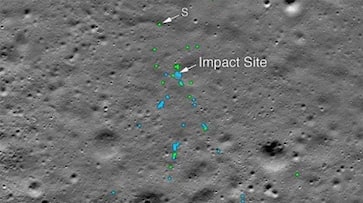NASA has released images of the impact site of the Vikram lander on the moon. NASA posted images clicked by its Lunar Reconnaissance Orbiter (LRO) Camera
Washington DC: NASA, on Tuesday (November 3), found Vikram lander of Chandrayaan-2. It also released images of its impact site on the moon, where the spacecraft had lost communication moments before making a soft landing on the far side of the lunar surface.
NASA posted images clicked by its Lunar Reconnaissance Orbiter (LRO) camera, showing the site's changes on the moon and the impact point before and after the spacecraft had made a hard-landing on the lunar surface.
It also indicated the impact spot of the lander and an associated debris field created by the crash with blue and green dots respectively.
"Green dots indicate spacecraft debris (confirmed or likely). Blue dots locate disturbed soil, likely where small bits of the spacecraft churned up the regolith. "S" indicates debris identified by Shanmuga Subramanian," the statement said without elaborating Subramanian's identity.
"Shanmuga Subramanian contacted the LRO project with a positive identification of debris. After receiving this tip, the LROC team confirmed the identification by comparing before and after images," it added.
"The Lunar Reconnaissance Orbiter Camera team released the first mosaic (acquired on September 17) of the site on September 26 and many people have downloaded the mosaic to search for signs of Vikram. When the images for the first mosaic were acquired the impact point was poorly illuminated and thus not easily identifiable. Two subsequent image sequences were acquired on October 14 and 15, and on November 11. The LROC team scoured the surrounding area in these new mosaics and found the impact site and associated debris field," the statement continued.
"The debris first located by Shanmuga is about 750 meters northwest of the main crash site and was a single bright pixel identification in that first mosaic," NASA further said.
Vikram lander was scheduled to make a soft-landing near the south pole of the moon on September 7. However, minutes before its scheduled soft-landing, ISRO had lost communication with the lander at 2.1 kilometres above the moon's surface.
Last Updated Dec 3, 2019, 8:06 AM IST









![Salman Khan sets stage on fire for Anant Ambani, Radhika Merchant pre-wedding festivities [WATCH] ATG](https://static-gi.asianetnews.com/images/01hr1hh8y86gvb4kbqgnyhc0w0/whatsapp-image-2024-03-03-at-12-24-37-pm_100x60xt.jpg)
![Pregnant Deepika Padukone dances with Ranveer Singh at Anant Ambani, Radhika Merchant pre-wedding bash [WATCH] ATG](https://static-gi.asianetnews.com/images/01hr1ffyd3nzqzgm6ba0k87vr8/whatsapp-image-2024-03-03-at-11-45-35-am_100x60xt.jpg)


